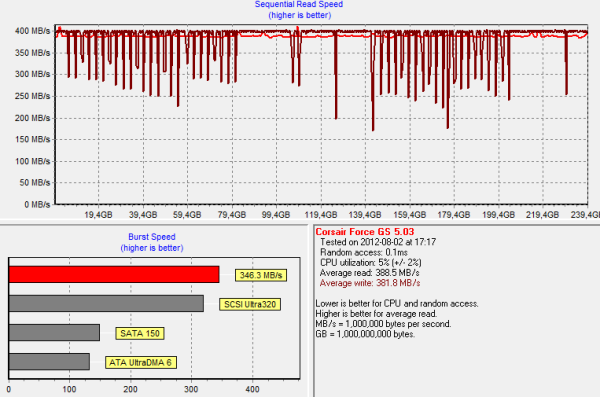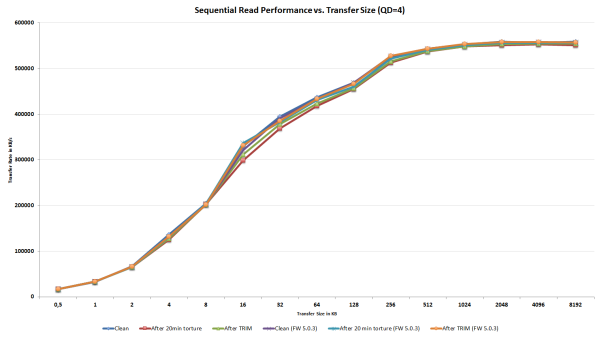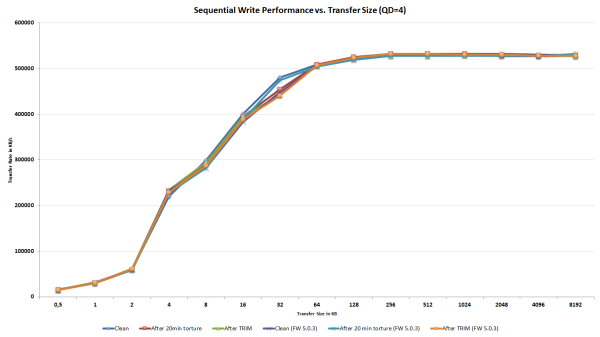SandForce TRIM Issue & Corsair Force Series GS (240GB) Review
by Kristian Vättö on November 22, 2012 1:00 PM ESTFirmware 5.0.3 to the Rescue
As SandForce was well aware of the issue with TRIM, it allowed them to work on a new firmware with working TRIM before the issue gained much visibility. The new firmware carries a version number 5.0.3, although manufacturers may rename the update to correspond with their one firmware naming schemes. Availability of the update depends totally on the manufacturer as all have their own validation processes, but so far I've seen at least Corsair, Kingston and SanDisk offering the updated firmware for their drives. Again, I would like to point out that not all SF-2281 based SSDs are affected; there are plenty still using the older 3.x.x firmware with working TRIM.
To test if TRIM finally works, I'm using the same methods as in the previous page. Here's what performance looks like after 20 minutes of torturing:
There are no essential differences from the 5.0.2 firmware. Read speed still degrades but like I said, this is most likely how the controller and firmware were designed, meaning that there isn't really a way to fix it.
Next I TRIM'ed the drive:
Read speed is mostly restored, though not fully, but TRIM is definitely working better than it was in 5.0.2 and earlier. It's actually normal that performance after TRIM is a few percent shy of clean performance, so the behavior we are seeing here is fairly common. However, we now have a new quirk: Write speed degradation. As you can see in the first graph, write speed after torture was 398MB/s. After TRIMing the drive, the average write speeds drops to ~382MB/s. Generally the write speed is around 400MB/s but there are at least two dozen peaks where performance drops to as low as ~175MB/s.
I TRIMed the drive again to see if there would be any improvement:
And there is ~9MB/s improvement in average write speed. Write speeds still drops below 200MB/s on several occasions but in total the amount of negative peaks is a lot smaller. With more sequential writes and idle time, write speed should restore to close to clean state performance.
I also ran ATTO to see if it would replicate our HD Tach results:
Read speed is restored after TRIM, which is what our HD Tach tests showed as well.
When tested with ATTO, write speed doesn't actually degrade aside from the transfer size of 32KB, though similar behavior happens with the 5.0.2 firmware. The above graph can be a bit hard to read because the lines are crossing each other, so I double-checked the results by looking at the raw numbers reported by ATTO and there were no major differences. Again, keep in mind that ATTO doesn't write anywhere near as much data as HD Tach does. Aside from the peaks, performance with HD Tach was similar to clean-state, so it's possible that ATTO doesn't write enough to show the peaks as well.


_575px.PNG)

_575px.PNG)










56 Comments
View All Comments
bradcollins - Thursday, November 22, 2012 - link
One question, all of the tests at Anandtech for Sandforce performance after being hammered for a period of time are always over the entire drive. Do the drives maintain their performance if the random writes are only over 50% or 75% of the LBA's on the drive? Very few people actually fill up their SSD so I wonder if it is a truely relevant test?Impulses - Wednesday, November 28, 2012 - link
You will always eventually use all of your SSD, wear leveling algorithms will spread data across all NAND packages... A certain portion will always be marked "empty" if you haven't filled it to capacity, but that space has been issued and it's subject to the performance degradation conditions AT tests for.Bullwinkle J Moose - Thursday, November 22, 2012 - link
Time for an article on Cache Analysis?It looks to me as though the 1GB Dram Cache on the Intel DC S3700 is mainly responsible for smoothing out those peaks and valleys to deliver "Consistant" performance across the drive
As for trim.....
It's time to start with a fresh perspective on SSD's
Bullwinkle J Moose - Thursday, November 22, 2012 - link
I know Intel claimed otherwise on the dram usage, but I don't buy itSounds more likely they are just sending the competition on a wild goose chase
Bullwinkle J Moose - Thursday, November 22, 2012 - link
Reread DC S3700 review again256MB of the 1GB is used for cache
OK, my bad
Bullwinkle J Moose - Thursday, November 22, 2012 - link
DohIf I read it 5 more times I'll get it right eventually
extide - Saturday, November 24, 2012 - link
If it were that easy, don't you think other guys would have drives like the 3700 out?Kristian Vättö - Friday, November 23, 2012 - link
The problem with caching in general is that there is no good way to test how much write/read caching the drive is doing. All we got is what manufacturers tell us, which may or may not be accurate.mayankleoboy1 - Friday, November 23, 2012 - link
With each review, Samsung 840Pro looks better and better.JellyRoll - Friday, November 23, 2012 - link
This information has been already hashed over by several sites, in particular TweakTown. They have been educating the public for months about the lack of TRIM with Sandforce SSDs.Other sites have also noticed the read degradation, and commented on it ad nauseum.